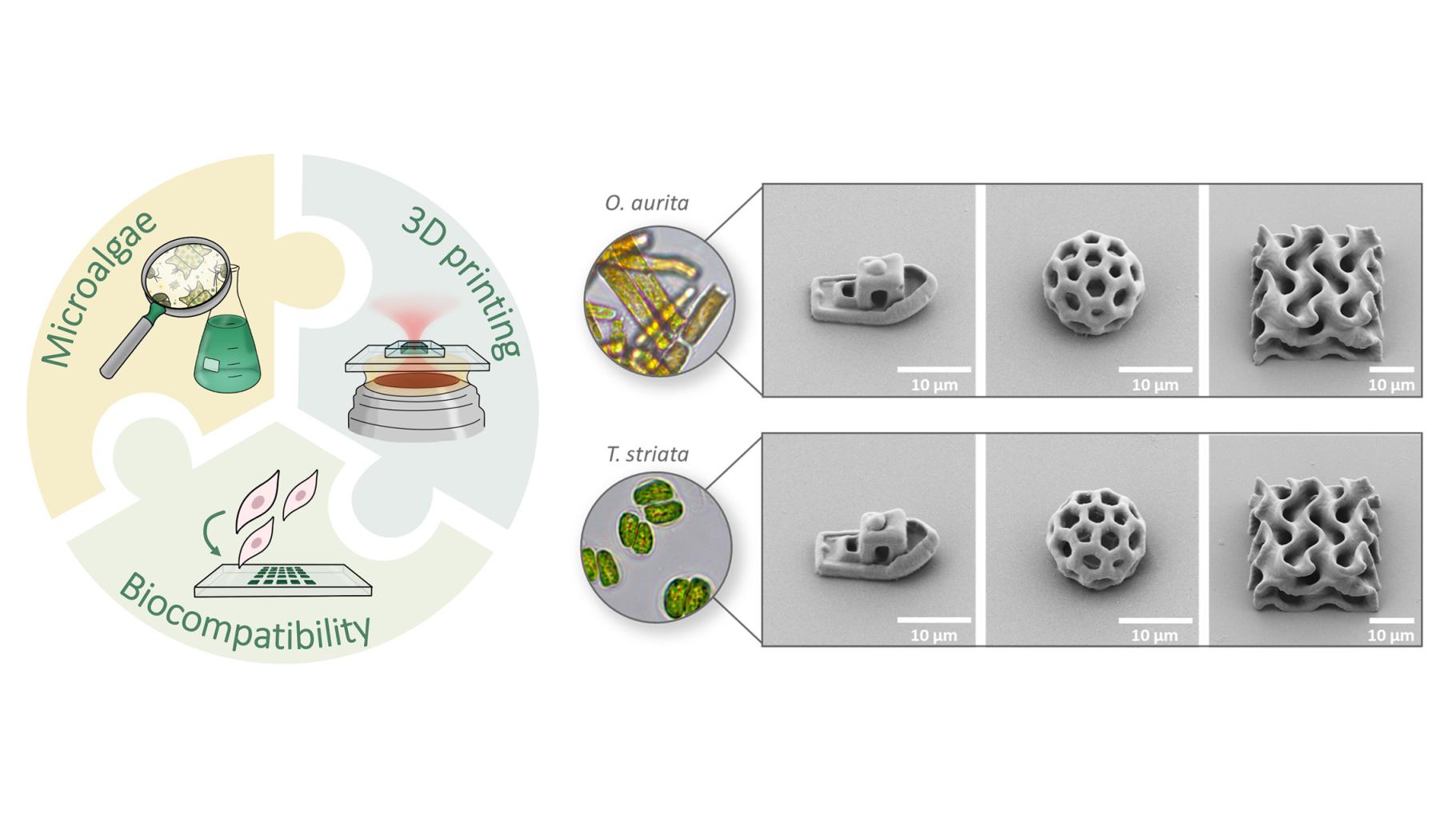日本語で読みたい方は、 google chromeで開き、
画面上で右クリックをして、「日本語に翻訳」をクリックしてください
Heidelberg researchers successfully develop a new generation of biocompatible materials for additive manufacturing
Microalgae such as the diatom Odontella aurita and the green alga Tetraselmis striata are especially suitable as “biofactories” for the production of sustainable materials for 3D laser printing due to their high content in lipids and photoactive pigments. An international research team led by Prof. Dr Eva Blasco, a scientist at the Institute for Molecular Systems Engineering and Advanced Materials (IMSEAM) of Heidelberg University, has succeeded for the first time in manufacturing inks for printing complex biocompatible 3D microstructures from the raw materials extracted from the microalgae. The microalgae-based materials could be used in future as the basis for implants or scaffolds for 3D cell cultures.

A new ink system, based on the microalgae Odontella aurita and Tetraselmis striata, enables the manufacturing of complex 3D microstructures with high quality and precision.
| © Clara Vazquez-Martel
Among the additive manufacturing techniques, two-photon 3D laser printing offers particular advantages for manufacturing at the micro- and nanoscale. Owing to its remarkable resolution, it finds application in numerous fields including optics and photonics, microfluidics, and biomedicine. The process involves focusing a laser beam on a liquid, photoreactive resin, a so-called “ink”. At the focal point, the laser light activates special molecules known as photoinitiators and triggers a chemical reaction, causing local solidification of the ink.
To date, petrochemical-based polymers have been mainly used as inks for this highly precise 3D laser printing process. However, these polymers contribute to the depletion of fossil fuels and the emission of greenhouse gases and can also contain toxic components, as Prof. Blasco points out. Microalgae are particularly well suited as “biofactories” for the production of sustainable materials for 3D printing due to their rapid growth rate, CO2-fixation during cultivation, and biocompatibility. “Despite their advantages, microalgae have hardly been considered as raw materials for light-based 3D printing,” says Prof. Blasco, whose group conducts research at the interface of macromolecular chemistry, materials science, and 3D nanofabrication.
The research team succeeded for the first time in extracting biocompatible materials for high-resolution 3D laser printing from microalgae. For their experiments, the researchers selected two species – the diatom Odontella aurita and the green alga Tetraselmis striata – that contain particularly high levels of lipids in the form of triglycerides. The team extracted the triglycerides and functionalized them with acrylates to facilitate rapid curing under light irradiation. The photoactive green pigments present in the microalgae proved to be suitable as photoinitiators. When exposed to light, they trigger the chemical reaction that solidifies the ink into a three-dimensional structure. “In this way we avoid using potentially toxic additives like the photoinitiators used in conventional inks,” explains first author Clara Vazquez-Martel, a doctoral candidate in Eva Blasco’s research team at IMSEAM.
Using the new ink system, the researchers were able to produce different 3D microstructures with high precision, exhibiting complex features such as overhanging roofs and cavities. Using cell culture experiments, the researchers also investigated the biocompatibility of the microalgae-based inks. They prepared 3D microscaffolds on which the cells were cultured for about 24 hours. They observed a survival rate of almost 100 percent. “Our results open up new possibilities not only for more sustainable 3D printing with light, but also for life science applications – from 3D cell cultures to biocompatible implants,” says Prof. Blasco.
The research was conducted within the Cluster of Excellence “3D Matter Made to Order”, a collaboration of Heidelberg University and the Karlsruhe Institute of Technology (KIT). This study involved researchers from Heidelberg, the KIT, and the Spanish Bank of Algae at the University of Las Palmas de Gran Canaria (ULPGC, Spain). The work was funded by the German Research Foundation, the Carl Zeiss Foundation, the Fonds der Chemischen Industrie, and the European Union in the framework of the European Territorial Cooperation Program. The research has been published in the journal “Advanced Materials”.
Original publication
C. Vazquez-Martel, L. Florido Martins, E. Genthner, C. Almeida, A. Martel Quintana, M. Bastmeyer, J. L. Gómez Pinchetti, E. Blasco: Printing Green: Microalgae-Based Materials for 3D Printing with Light. Advanced Materials (14 June 2024).
出典:
https://www.uni-heidelberg.de/en/newsroom/3d-laser-printing-with-bioinks-from-microalgae
ご参考:
(株)光響が提供する製品・サービス情報:
・300W シングルモジュール連続レーザー(3Dプリント)(Maxphotonics社製)
In case of addition or removal of the article, please contact us as below:
info@symphotony.com
記事の追加及び削除:
記事の追加あるいは削除を希望される場合、お手数ではございますが、
以下窓口までご連絡ください。
info@symphotony.com
この情報へのアクセスはメンバーに限定されています。ログインしてください。メンバー登録は下記リンクをクリックしてください。

